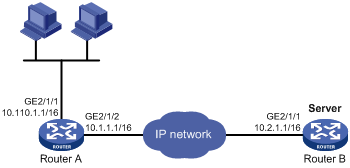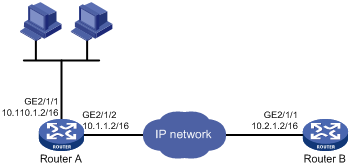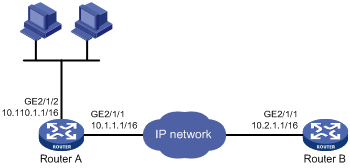- Table of Contents
-
- 06-Layer 3 - IP Services Configuration Guide
- 00-Preface
- 01-ARP configuration
- 02-IP addressing configuration
- 03-DHCP configuration
- 04-DNS configuration
- 05-NAT configuration
- 06-IP forwarding basics configuration
- 07-Fast forwarding configuration
- 08-Flow classification configuration
- 09-Adjacency table configuration
- 10-IRDP configuration
- 11-IP performance optimization configuration
- 12-UDP Helper configuration
- 13-IPv6 basics configuration
- 14-DHCPv6 configuration
- 15-IPv6 fast forwarding configuration
- 16-Tunneling configuration
- 17-GRE configuration
- 18-ADVPN configuration
- 19-AFT configuration
- 20-WAAS configuration
- Related Documents
-
| Title | Size | Download |
|---|---|---|
| 12-UDP Helper configuration | 94.59 KB |
Configuration restrictions and guidelines
Configuring UDP helper to convert broadcast to unicast
Configuring UDP helper to convert broadcast to multicast
Configuring UDP helper to convert multicast to broadcast or unicast
Displaying and maintaining UDP helper
UDP helper configuration examples
Configuring UDP helper to convert broadcast to unicast
Configuring UDP helper
Overview
UDP helper can provide the following packet conversion for packets with specific UDP destination port numbers:
· Convert broadcast to unicast, and forward the unicast packets to specific destinations.
· Convert broadcast to multicast, and forward the multicast packets.
· Convert multicast to broadcast or unicast, and forward the broadcast or unicast packets.
Configuration restrictions and guidelines
When you configure UDP helper, follow these restrictions and guidelines:
· Do not set UDP ports 67 and 68 for UDP helper, because UDP helper cannot forward DHCP broadcast packets.
· You can specify a maximum of 256 UDP ports for UDP helper.
· You can specify a maximum of 20 unicast and multicast addresses for UDP helper to convert broadcast packets on an interface.
· You can map one multicast address to a maximum of 16 broadcast and unicast addresses for UDP helper to convert multicast packets on an interface.
Configuring UDP helper to convert broadcast to unicast
You can configure UDP helper to convert broadcast packets with specific UDP port numbers to unicast packets.
Upon receiving a UDP broadcast packet, UDP helper uses the configured UDP ports to match the UDP destination port number of the packet.
· If a match is found, UDP helper duplicates the packet and modifies the destination IP address of the copy to the configured unicast address. Then UDP helper forwards the unicast packet to the unicast address.
· If no match is found, UDP helper does not process the packet.
To configure UDP helper to convert broadcast to unicast:
|
Step |
Command |
Remarks |
|
1. Enter system view. |
system-view |
N/A |
|
2. Enable UDP helper. |
udp-helper enable |
By default, UDP helper is disabled. |
|
3. Specify a UDP port number. |
udp-helper port { port-number | dns | netbios-ds | netbios-ns | tacacs | tftp | time } |
By default, no UDP port numbers are specified. |
|
4. Enter interface view. |
interface interface-type interface-number |
N/A |
|
5. Specify a destination server for UDP helper to convert broadcast to unicast. |
udp-helper server ip-address [ global | vpn-instance vpn-instance-name ] |
By default, no destination server is specified. If you specify multiple destination servers, UDP helper creates one copy for each server. Use this command on the interface that receives broadcast packets. |
Configuring UDP helper to convert broadcast to multicast
You can configure UDP helper to convert broadcast packets with specific UDP port numbers to multicast packets.
Upon receiving a UDP broadcast packet, UDP helper uses the configured UDP ports to match the UDP destination port number of the packet.
· If a match is found, UDP helper duplicates the packet and modifies the destination IP address of the copy to the configured multicast address. Then UDP helper forwards the packet to the multicast group.
· If no match is found, UDP helper does not process the packet.
To configure UDP helper to convert broadcast to multicast:
|
Step |
Command |
Remarks |
|
1. Enter system view. |
system-view |
N/A |
|
2. Enable UDP helper. |
udp-helper enable |
By default, UDP helper is disabled. |
|
3. Specify a UDP port number. |
udp-helper port { port-number | dns | netbios-ds | netbios-ns | tacacs | tftp | time } |
By default, no UDP port numbers are specified. |
|
4. Enter interface view. |
interface interface-type interface-number |
N/A |
|
5. Specify a destination multicast address for UDP helper to convert broadcast to multicast. |
udp-helper broadcast-map multicast-address [ acl acl-number ] |
By default, no destination multicast address is specified for UDP helper. If you specify multiple multicast addresses, UDP helper creates one copy for each address. Use this command on the interface that receives broadcast packets. |
Configuring UDP helper to convert multicast to broadcast or unicast
You can configure UDP helper to convert multicast packets with specific UDP port numbers and multicast addresses to broadcast or unicast packets.
Upon receiving a UDP multicast packet, UDP helper uses the configured UDP ports to match the UDP destination port number of the packet.
· If a match is found, UDP helper searches the configured mappings based on the packet's destination multicast address.
¡ UDP helper duplicates the packet and modifies the copy's destination IP address to the broadcast or unicast address in the matched mapping. Then UDP helper forwards the packet to its destination.
¡ If no match is found, UDP helper does not process the packet.
· If the packet's destination port number does not match the configured UDP ports, UDP helper does not process the packet.
To configure UDP helper to convert multicast to broadcast or unicast:
|
Step |
Command |
Remarks |
|
1. Enter system view. |
system-view |
N/A |
|
2. Enable UDP helper. |
udp-helper enable |
By default, UDP helper is disabled. |
|
3. Specify a UDP port number. |
udp-helper port { port-number | dns | netbios-ds | netbios-ns | tacacs | tftp | time } |
By default, no UDP port numbers are specified. |
|
4. Enter interface view. |
interface interface-type interface-number |
N/A |
|
5. Map a multicast address to a directed broadcast or a unicast address for UDP helper. |
udp-helper multicast-map multicast-address ip-address [ global | vpn-instance vpn-instance-name ] [ acl acl-number ] |
By default, no address mapping is specified for UDP helper. If you specify multiple multicast and unicast addresses, UDP helper creates one copy for each address. For multicast to broadcast conversion, do not specify a limited broadcast address for the ip-address argument. Use this command on the interface that receives multicast packets. |
Displaying and maintaining UDP helper
Execute display command in any view and reset commands in user view.
|
Task |
Command |
|
Display information about broadcast to unicast conversion by UDP helper on an interface. |
display udp-helper interface interface-type interface-number |
|
Clear packet statistics for UDP helper. |
reset udp-helper statistics |
UDP helper configuration examples
Configuring UDP helper to convert broadcast to unicast
Network requirements
As shown in Figure 1, configure UDP helper to convert broadcast to unicast on GigabitEthernet 2/1/1 of Router A. This feature enables Router A to forward broadcast packets with UDP destination port 55 to the destination server 10.2.1.1/16.

Configuration procedure
Make sure Router A can reach the subnet 10.2.0.0/16.
# Enable UDP helper.
<RouterA> system-view
[RouterA] udp-helper enable
# Specify the UDP port 55 for UDP helper.
[RouterA] udp-helper port 55
# Specify the destination server 10.2.1.1 for UDP helper to convert broadcast to unicast on GigabitEthernet 2/1/1.
[RouterA] interface gigabitethernet 2/1/1
[RouterA-GigabitEthernet2/1/1] ip address 10.110.1.1 16
[RouterA-GigabitEthernet2/1/1] udp-helper server 10.2.1.1
Verifying the configuration
# Display information about broadcast to unicast conversion by UDP helper on GigabitEthernet 2/1/1.
[RouterA-GigabitEthernet2/1/1] display udp-helper interface gigabitethernet 2/1/1
Interface Server VPN instance Server address Packets sent
GigabitEthernet2/1/1 N/A 10.2.1.1 5
Configuring UDP helper to convert broadcast to multicast
Network requirements
As shown in Figure 2, Router B can receive multicast packets destined for 225.1.1.1.
Configure UDP helper to convert broadcast to multicast on GigabitEthernet 2/1/1 of Router A. This feature enables Router A to forward broadcast packets with UDP destination port number 55 to the multicast group 225.1.1.1.

Configuration procedure
Make sure Router A can reach the subnet 10.2.0.0/16.
# Enable UDP helper.
<RouterA> system-view
[RouterA] udp-helper enable
# Enable the UDP port 55 for UDP helper.
[RouterA] udp-helper port 55
# Configure UDP helper to convert broadcast packets to multicast packets destined for 225.1.1.1 on GigabitEthernet 2/1/1.
[RouterA] interface gigabitethernet 2/1/1
[RouterA-GigabitEthernet2/1/1] ip address 10.110.1.1 16
[RouterA-GigabitEthernet2/1/1] udp-helper broadcast-map 225.1.1.1
[RouterA-GigabitEthernet2/1/1] quit
# Enable IP multicast routing globally.
[RouterA] multicast routing
[RouterA-mrib] quit
# Enable PIM-DIM and IGMP on GigabitEthernet 2/1/1.
[RouterA] interface gigabitethernet 2/1/1
[RouterA-GigabitEthernet2/1/1] pim dm
[RouterA-GigabitEthernet2/1/1] igmp enable
# Configure GigabitEthernet 2/1/1 as a static member of the multicast group 225.1.1.1.
[RouterA-GigabitEthernet2/1/1] igmp static-group 225.1.1.1
# Enable PIM-DIM and IGMP on GigabitEthernet 2/1/2.
[RouterA-GigabitEthernet2/1/2] pim dm
[RouterA-GigabitEthernet2/1/2] igmp enable
# Configure GigabitEthernet 2/1/2 as a static member of the multicast group 225.1.1.1.
[RouterA-GigabitEthernet2/1/2] igmp static-group 225.1.1.1
Verifying the configuration
Verify that you can capture multicast packets from Router A on Router B.
Configuring UDP helper to convert multicast to broadcast
Network requirements
As shown in Figure 3, GigabitEthernet 2/1/1 of Router B is a member of the multicast group 225.1.1.1.
Configure UDP helper to convert multicast to broadcast on GigabitEthernet 2/1/1 of Router A. This feature enables Router A to forward multicast packets from Router B to all hosts on 10.110.0.0/16. The multicast packets have the following details:
· UDP destination port number 55.
· Destination IP address 225.1.1.1.

Configuration procedure
Make sure Router A can reach the subnet 10.2.0.0/16.
# Enable UDP helper.
<RouterA> system-view
[RouterA] udp-helper enable
# Enable the UDP port 55 for UDP helper.
[RouterA] udp-helper port 55
# Configure UDP helper to convert multicast packets destined for 225.1.1.1 to broadcast packets destined for 10.110.255.255.
[RouterA] interface gigabitethernet 2/1/1
[RouterA-GigabitEthernet2/1/1] udp-helper multicast-map 225.1.1.1 10.110.255.255
Verifying the configuration
Verify that you can capture broadcast packets on all hosts on the network segment 10.110.0.0/16. The broadcast packets are from Router A.

